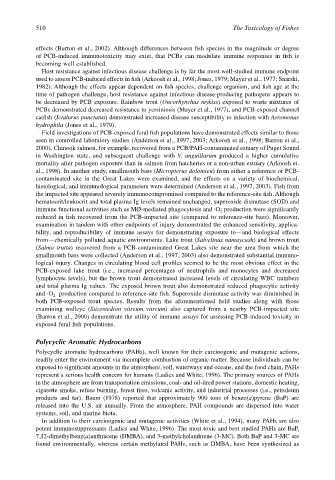Page 530 - The Toxicology of Fishes
P. 530
510 The Toxicology of Fishes
effects (Burton et al., 2002). Although differences between fish species in the magnitude or degree
of PCB-induced immunotoxicity may exist, that PCBs can modulate immune responses in fish is
becoming well established.
Host resistance against infectious disease challenge is by far the most well-studied immune endpoint
used to assess PCB-induced effects in fish (Arkoosh et al., 1998; Jones, 1979; Mayer et al., 1977; Snarski,
1982). Although the effects appear dependent on fish species, challenge organism, and fish age at the
time of pathogen challenge, host resistance against infectious-disease-producing pathogens appears to
be decreased by PCB exposure. Rainbow trout (Oncorhynchus mykiss) exposed to waste mixtures of
PCBs demonstrated decreased resistance to yersiniosis (Mayer et al., 1977), and PCB-exposed channel
catfish (Ictalurus punctatus) demonstrated increased disease susceptibility to infection with Aeromonas
hydrophila (Jones et al., 1979).
Field investigations of PCB-exposed feral fish populations have demonstrated effects similar to those
seen in controlled laboratory studies (Anderson et al., 1997, 2003; Arkoosh et al., 1998; Barron et al.,
2000). Chinook salmon, for example, recovered from a PCB/PAH-contaminated estuary of Puget Sound
in Washington state, and subsequent challenge with V. anguillarum produced a higher cumulative
mortality after pathogen exposure than in salmon from hatcheries or a non-urban estuary (Arkoosh et.
al., 1998). In another study, smallmouth bass (Micropterus dolomieu) from either a reference or PCB-
contaminated site in the Great Lakes were examined, and the effects on a variety of biochemical,
histological, and immunological parameters were determined (Anderson et al., 1997, 2003). Fish from
the impacted site appeared severely immunocompromised compared to the reference-site fish. Although
hematocrit/leukocrit and total plasma Ig levels remained unchanged, superoxide dismutase (SOD) and
immune functional activities such as MØ-mediated phagocytosis and ·O production were significantly
–
2
reduced in fish recovered from the PCB-impacted site (compared to reference-site bass). Moreover,
examination in tandem with other endpoints of injury demonstrated the enhanced sensitivity, applica-
bility, and reproducibility of immune assays for demonstrating exposure to—and biological effects
from—chemically polluted aquatic environments. Lake trout (Salvelinus namaycush) and brown trout
(Salmo trutta) recovered from a PCB-contaminated Great Lakes site near the area from which the
smallmouth bass were collected (Anderson et al., 1997, 2003) also demonstrated substantial immuno-
logical injury. Changes in circulating blood cell profiles seemed to be the most obvious effect in the
PCB-exposed lake trout (i.e., increased percentages of neutrophils and monocytes and decreased
lymphocyte levels), but the brown trout demonstrated increased levels of circulating WBC numbers
and total plasma Ig values. The exposed brown trout also demonstrated reduced phagocytic activity
–
and ·O production compared to reference-site fish. Superoxide dismutase activity was diminished in
2
both PCB-exposed trout species. Results from the aforementioned field studies along with those
examining walleye (Stizostedion vitreum vitreum) also captured from a nearby PCB-impacted site
(Barron et al., 2000) demonstrate the utility of immune assays for assessing PCB-induced toxicity in
exposed feral fish populations.
Polycyclic Aromatic Hydrocarbons
Polycyclic aromatic hydrocarbons (PAHs), well known for their carcinogenic and mutagenic actions,
readily enter the environment via incomplete combustion of organic matter. Because individuals can be
exposed to significant amounts in the atmosphere, soil, waterways and oceans, and the food chain, PAHs
represent a serious health concern for humans (Ladics and White, 1996). The primary sources of PAHs
in the atmosphere are from transportation emissions, coal- and oil-fired power stations, domestic heating,
cigarette smoke, refuse burning, forest fires, volcanic activity, and industrial processes (i.e., petroleum
products and tar). Baum (1978) reported that approximately 900 tons of benzo(a)pyrene (BaP) are
released into the U.S. air annually. From the atmosphere, PAH compounds are dispersed into water
systems, soil, and marine biota.
In addition to their carcinogenic and mutagenic activities (White et al., 1994), many PAHs are also
potent immunosuppressants (Ladics and White, 1996). The most toxic and best studied PAHs are BaP,
7,12-dimethylbenz(a)anthracene (DMBA), and 3-methylcholanthrene (3-MC). Both BaP and 3-MC are
found environmentally, whereas certain methylated PAHs, such as DMBA, have been synthesized as

